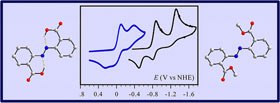Publication
750
J. Am. Chem. Soc., 136 (25), 8907-8910, 2014
DOI:10.1021/ja504484a
|
|
|
|
|
|
|

|
Proton-coupled electron transfer in azobenzene-hydrazobenzene couples with pending acid-base functions. Hydrogen-bonding and structural effects. |
|
|
|
Jean-Michel Savéant and Cédric Tard
Université Paris Diderot, Sorbonne Paris Cité, Laboratoire d’Electrochimie Moléculaire, Unité Mixte de Recherche Université - CNRS N° 7591, Bâtiment Lavoisier, 15 rue Jean de Baïf, 75205 Paris Cedex 13, France
Electron transfer in azobenzene derivatives bearing two carboxylic acid groups is coupled with intramolecular proton transfer in a stepwise manner in the title 2e– + 2H+ redox couple. The presence of the pendant acid–base functions pushes the redox chemistry of the azo/hydrazo couple toward positive potentials by as much as 0.75 V. This is essentially the result of H-bonding of one of the nitrogen atoms by the neighboring carboxylic group and H-bonding of one carboxylate by the neighboring protonated nitrogen atom. The two electron-transfer reactions, particularly the second one, are accompanied by strong structural changes, which results in the occurrence of a square scheme mechanism in which electron transfer and structural change are not concerted. These are typical phenomena that are likely to be encountered when attempting to boost proton-coupled electron-transfer stoichiometric or catalytic processes by installing pendant acid–base functionalities in the close vicinity of the reacting center. |

